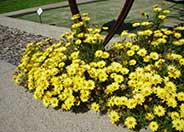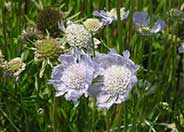
Common name:Black-Eyed Stella Hybrid Daylily
Botanical name:Hemerocallis 'Black-Eyed Stella'
The first All-America Daylily Award Winner! Bright yellow/gold with a reddish eyezone and dark blue-green foliage. Excellent for mass displays.
Created from Stella de Oro, the most successful daylily in history, Black-Eyed Stella was the result of over three thousand hybrid crosses. It has been rated as excellent for growth in eight zones across the US and Canada.- Greenwood Daylily Gardens

Common name:Mexican Bush Sage
Botanical name:Salvia leucantha
The Mexican sage is a bushy shrub that grows 3-4 ft. tall and wide. It has hairy white stems, gray-green leaves and velvet like purple flower spikes that bloom summer through fall. This shrub tolerates sun, light shade, little water, and is hardy to 15 degrees F. The Mexican sage is drought tolerant and attracts hummingbirds. -Cornflower Farms

Common name:Bearberry
Botanical name:Arctostaphylos uva-ursi
A hardy, creeping evergreen shrub, it grows 6-12" high and spreads as much as 10-12'. It has glossy green leathery leaves attached to dark brown branches. Its flowers are white to light pink in late winter and early spring; berries are bright red.

Common name:Red Star Autumn Sage
Botanical name:Salvia greggii 'Red Star'
This shrub will grow 1-4' tall and 1-4' wide. It has glossy green leaves with red flowers that bloom from fall to spring.

Common name:Arctotis Daisy, African Daisy
Botanical name:Arctotis hybrids
African Daisy hybrids grow 12-18" high x 12" wide and produce daisy-like flowers from spring through summer. These hybrids have lobed leaves and bloom in whtie, pink, red, purple, cream and orange. For trailing African Daisies, see Osteospermum fruticosum, or 'Freeway Daisy'.

Common name:Pincushion Flower
Botanical name:Scabiosa caucasica
A perennial, cushion-form ground cover or bedding plant, growing 1 to 2 feet tall, 2-3 feet wide. White, bluish and lavender colored pom pom like flowers rise above the foliage.
Designer:
Photographer: GardenSoft
Practice grass-cycling by leaving short grass clippings on lawns after mowing, so that nutrients and organic matter are returned to the soil.
Drip and other smart irrigation delivers water directly to roots, allowing no excess water for weeds.